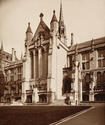 The First World War brought to an end church-building in Glasgow and, after the War, economic conditions did not favour expansion. During the 1920s only four important new churches were built, Cathcart Old, St Margaret's Knightswood (1929-32), St Enoch Hogganfield (1927-30) and Mosspark (1925-29). All were stone-built, as was the early 1930s St John's Renfield. All these served new housing areas. The economic recovery that followed the severe recession of the early 1930s saw massive expansion of housing, but money remained scarce. The response of the Church of Scotland and the Catholic Church was to use unorthodox materials. Both used brick rather than stone. The Catholic churches were more innovative: notably in Gillespie, Kidd & Coia's St Anne's, Dennistoun (1933), and St Columba's, Hopehill Road (completed 1941), both of which used reinforced concrete in their construction. The Church of Scotland built King's Park Church (1931-32) as a prototype for churches for new housing areas and others followed in Lambhill, Parkhead, Knightswood and Croftfoot. A concrete-famed church was constructed at Garrowhill. The part of the United Free Church that stayed out of a union with the Church of Scotland in 1929 also built small harled brick churches in Cathcart, Thornwood and Knightswood.
The First World War brought to an end church-building in Glasgow and, after the War, economic conditions did not favour expansion. During the 1920s only four important new churches were built, Cathcart Old, St Margaret's Knightswood (1929-32), St Enoch Hogganfield (1927-30) and Mosspark (1925-29). All were stone-built, as was the early 1930s St John's Renfield. All these served new housing areas. The economic recovery that followed the severe recession of the early 1930s saw massive expansion of housing, but money remained scarce. The response of the Church of Scotland and the Catholic Church was to use unorthodox materials. Both used brick rather than stone. The Catholic churches were more innovative: notably in Gillespie, Kidd & Coia's St Anne's, Dennistoun (1933), and St Columba's, Hopehill Road (completed 1941), both of which used reinforced concrete in their construction. The Church of Scotland built King's Park Church (1931-32) as a prototype for churches for new housing areas and others followed in Lambhill, Parkhead, Knightswood and Croftfoot. A concrete-famed church was constructed at Garrowhill. The part of the United Free Church that stayed out of a union with the Church of Scotland in 1929 also built small harled brick churches in Cathcart, Thornwood and Knightswood.
 The Second World War, like its predecessor, put an effective end to church-building and, although it was not followed by recession, there was a severe shortage of materials. Few churches therefore were built between 1945 and 1950. St Paul's Provanmill (1948-51) was the first post-war building for the Church of Scotland.
The Second World War, like its predecessor, put an effective end to church-building and, although it was not followed by recession, there was a severe shortage of materials. Few churches therefore were built between 1945 and 1950. St Paul's Provanmill (1948-51) was the first post-war building for the Church of Scotland.